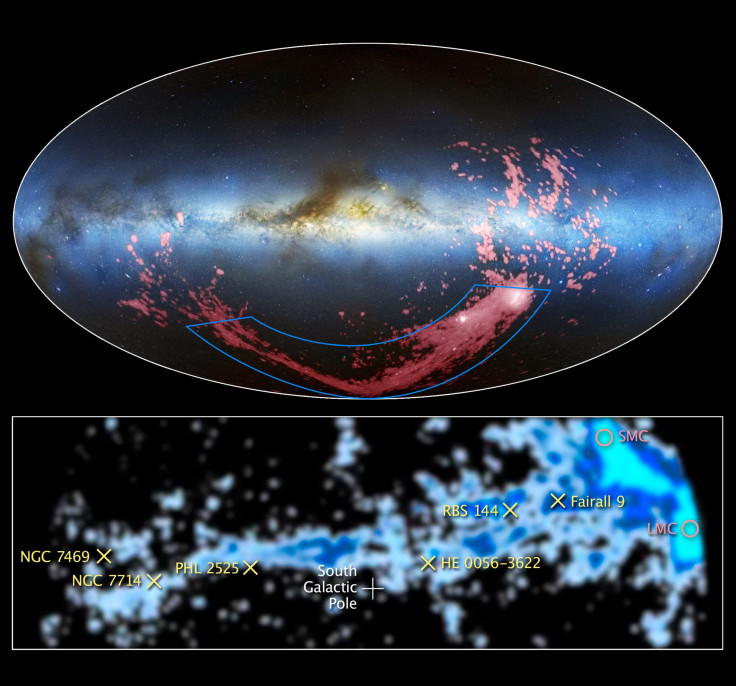Hubble Space Telescope Solves Mystery Of Massive Gas Ribbon That Stretches Across The Milky Way
The mystery of how a gas ribbon that stretches halfway across the Milky Way came to be has been solved, astronomers say. The Magellanic Stream was created by gas pulled primarily from the Small Magellanic Cloud approximately 2 billion years ago, new research finds.

The Small Magellanic Cloud and the Large Magellanic Cloud are two dwarf galaxies approximately 199,000 light-years and 163,000 light-years, respectively, from Earth. The gas cloud making up the Magellanic Stream was first observed in the 1960s, but astronomers made the connection between the gas stream and the "clouds" in the early 1970s. While astronomers knew the Magellanic Stream must have come from one of the mini-galaxies, or some combination of the two, it was unclear what role each galaxy played in the creation of the stream.
Using the Hubble Space Telescope, astronomers were able to determine the majority of the Magellanic Stream was created from gas torn away from the Small Cloud. The research was led by Andrew Fox, from the Space Telescope Science Institute in Baltimore, and the astronomers used Hubble’s Cosmic Origins Spectrograph and the European Southern Observatory’s Very Large Telescope to identify the Magellanic Stream’s origin. The research was published in The Astrophysical Journal.
The astronomers used Hubble’s COS to measure the levels of oxygen and sulfur in six locations within the Magellanic Stream and compared it with the levels found in the Small and Large Clouds. Based on the results, the researchers concluded the levels of sulfur and oxygen in the stream matched those found in the Small Cloud 2 billion years ago, a timeframe that matched the believed date of the stream’s creation. While low levels of sulfur and oxygen were linked to the Small Cloud, higher levels of sulfur and oxygen found in the stream closer to the two galaxies match those found in the Large one.
Based on these results, the astronomers believe gas was ripped from the Large Cloud at a more recent date. According to NASA, previous models suggested the stream was made primarily from gas from the Small Cloud as it has a weaker gravitational pull than the Large Cloud. With the help of the Milky Way’s own gravitational pull, gas from the Small Cloud and, later, the Large Cloud was pulled into space, thus creating the Magellanic Stream.
Fox said the Magellanic Stream could, eventually, become part of the Milky Way. He said in a statement, “We now know which of our famous neighbors, the Magellanic Clouds, created this gas ribbon, which may eventually fall onto our own galaxy and spark new star formation. It's an important step forward in figuring out how galaxies obtain gas and form new stars.” Because of the close proximity of the two galaxies, astronomers can observe star formation as well as test theories about galaxy growth.
© Copyright IBTimes 2024. All rights reserved.






















